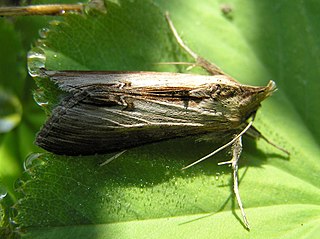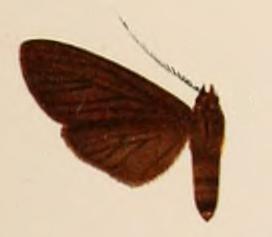Schausiana is a monotypic moth genus of the family Hepialidae described by Pierre Viette in 1950. The only described species is Schausiana trojesa, described by William Schaus in 1901, which is endemic to Mexico.

Cucullia asteris (star-wort) is a species of moth of the family Noctuidae. It is found through the Palearctic including Japan.

Setina irrorella, the dew moth, is a moth of the family Erebidae. The species was first described by Carl Linnaeus in his 1758 10th edition of Systema Naturae. It is found in the Palearctic from Ireland, then through Europe and east to northern and central Asia to the Pacific Ocean. It is missing in the high north and parts of the Mediterranean region. It is found also in the limestone Alps up to 2,000 meters above sea level.

Pelochyta is a genus of moths in the family Erebidae. The species was first described by Jacob Hübner in 1819. They are distributed in Africa, throughout India, Myanmar, Sri Lanka, Australia and New Britain.
Cibyra brunnea is a species of moth of the family Hepialidae. It was described by William Schaus in 1901 and is known from Venezuela and Peru.
Cibyra ferruginosa is a species of moth of the family Hepialidae. It was described by Francis Walker in 1856 and is known to live in the northeastern region of Brazil.
Cibyra poltrona is a species of moth of the family Hepialidae. It was described by William Schaus in 1901 and is known from Brazil.
Cibyra tesselloides is a species of moth of the family Hepialidae. It was described by William Schaus in 1901 and is known from Brazil and Paraguay.
Druceiella basirubra is a species of moth of the family Hepialidae. It was described by William Schaus in 1901 and is known from Bolivia and Peru.
Endoclita purpurescens is a species of moth of the family Hepialidae. It was described by Frederic Moore in 1883 and is known from Sri Lanka. Food plants for this species include Camellia and Cinchona.
Eulepidotis aglae is a moth of the family Erebidae first described by William Schaus in 1921. It is found in the Neotropics, including Guatemala.
Givira platea is a moth in the family Cossidae. It was described by William Schaus in 1901 and it is found in Brazil.
Givira durangona is a moth in the family Cossidae described by William Schaus in 1901. It is found in Mexico (Durango) and the United States, where it has been recorded from Colorado.
Hypopta pallidicosta is a moth in the family Cossidae. It was described by William Schaus in 1901 and it is found in Paraná, Brazil.
Givira quadra is a moth in the family Cossidae described by William Schaus in 1901. It is found in Costa Rica, Brazil and Paraguay.
Givira plagiata is a moth in the family Cossidae. It was described by William Schaus in 1901 and is found in Venezuela.
Polygrammodes supremalis is a moth in the family Crambidae. It was described by William Schaus in 1920. It is found in Paraná, Brazil.
Oreta subvinosa is a moth in the family Drepanidae. It was described by William Warren in 1903. It is found in New Guinea, where it is known from Papua.
Costria elegans is a species of moth in the family Cossidae. It was described by William Schaus in 1901 and is found in South America.
Megalopyge lapena is a moth of the family Megalopygidae. It was described by Schaus in 1896. It is found in Mexico and southern Arizona.

